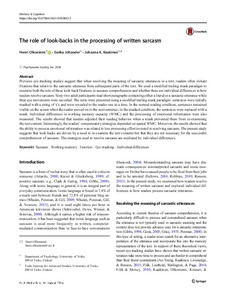The role of look-backs in the processing of written sarcasm
Johanna Kaakinen; Eerika Johander; Henri Olkoniemi
https://urn.fi/URN:NBN:fi-fe2021042719645
Tiivistelmä
Previous eye-tracking studies suggest that when resolving the meaning of
sarcastic utterances in a text, readers often initiate fixations that
return to the sarcastic utterance from subsequent parts of the text. We
used a modified trailing mask paradigm to examine both the role of these
look-back fixations in sarcasm comprehension and whether there are
individual differences in how readers resolve sarcasm. Sixty-two adult
participants read short paragraphs containing either a literal or a
sarcastic utterance while their eye movements were recorded. The texts
were presented using a modified trailing mask paradigm: sentences were
initially masked with a string of x’s and were revealed to the reader
one at a time. In the normal reading condition, sentences remained
visible on the screen when the reader moved on to the next sentence; in
the masked condition, the sentences were replaced with a mask.
Individual differences in working memory capacity (WMC) and the
processing of emotional information were also measured. The results
showed that readers adjusted their reading behavior when a mask
prevented them from re-examining the text content. Interestingly, the
readers’ compensatory strategies depended on spatial WMC. Moreover, the
results showed that the ability to process emotional information was
related to less processing effort invested in resolving sarcasm. The
present study suggests that look-backs are driven by a need to
re-examine the text contents but that they are not necessary for the
successful comprehension of sarcasm. The strategies used to resolve
sarcasm are mediated by individual differences.
Kokoelmat
- Rinnakkaistallenteet [19207]
